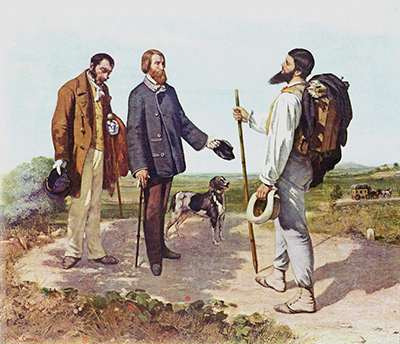The Meeting is widely accepted as depicting the artist meeting up with one of his donors and a servant whilst out walking in the countryside. There is also a small dog in the background which adds to the personal feeling of this work.
The painting was disrespectfully labelled as 'Bonjour, Monsieur Courbet' by art critics who immediately rejected it once it was exhibited. Sadly, Courbet received this type of treatment in many other cases too, and struggled for academic acceptance in France despite the clear qualities of his work. Sometimes artists are not truly understood and appreciated into several generations later, particularly when making use of groundbreaking styles and techniques that many are not ready for during the artist's own lifetime. Courbet is just one example of many who suffered this fate.
Alfred Bruyas, specifically, is the patron captured here. He was a passioniate follower of the arts and eventually gifted his substantial collection to Musée Fabre in Montpellier. It is believed that his servant was called Calas. The Musée Fabre owes Bruyas a huge debt of gratitude for his generosity and he would be pleased to know that much of what he handed over remains at this impressive institution. It is normally the case to see such a collection within the French capital and so to see classic paintings by the likes of Nicolas Poussin, Jacques-Louis David, Gian Lorenzo Bernini, Annibale Carracci, Peter Paul Rubens and Eugène Delacroix in a more provincial setting opens art history up to a new crowd.
Influential donors were essential during past centuries as they could bring exposure as well as adding a level of approval to an artist's career. Many had to supplement their careers with other types of work in order to continue working on the types of projects that they most enjoyed. Financial backing from family members or key connections such as this would help to lift thi burden and allow an artist to concentrate on fulfilling his potential rather than wasting time producing sellable portraits or the like. European society was even more classed-based than it is today, meaning relationships were a necessary evil in order to promote one's career.




